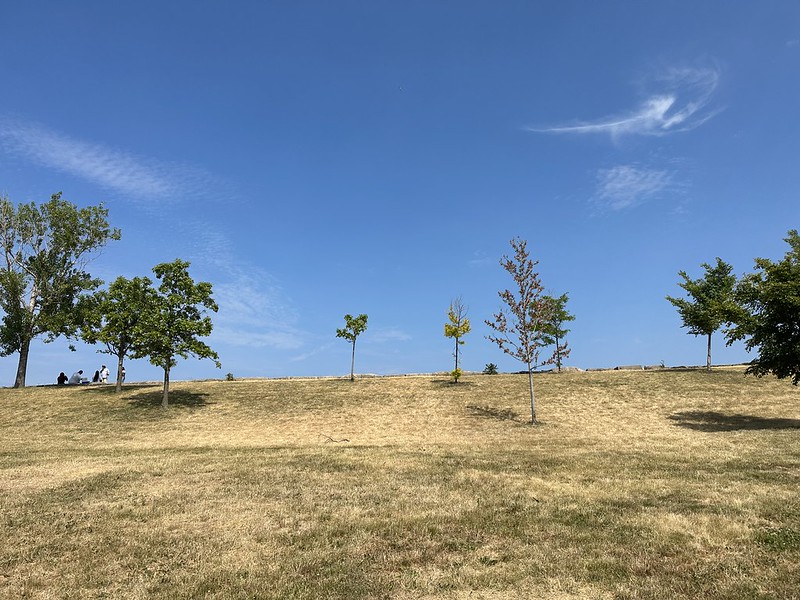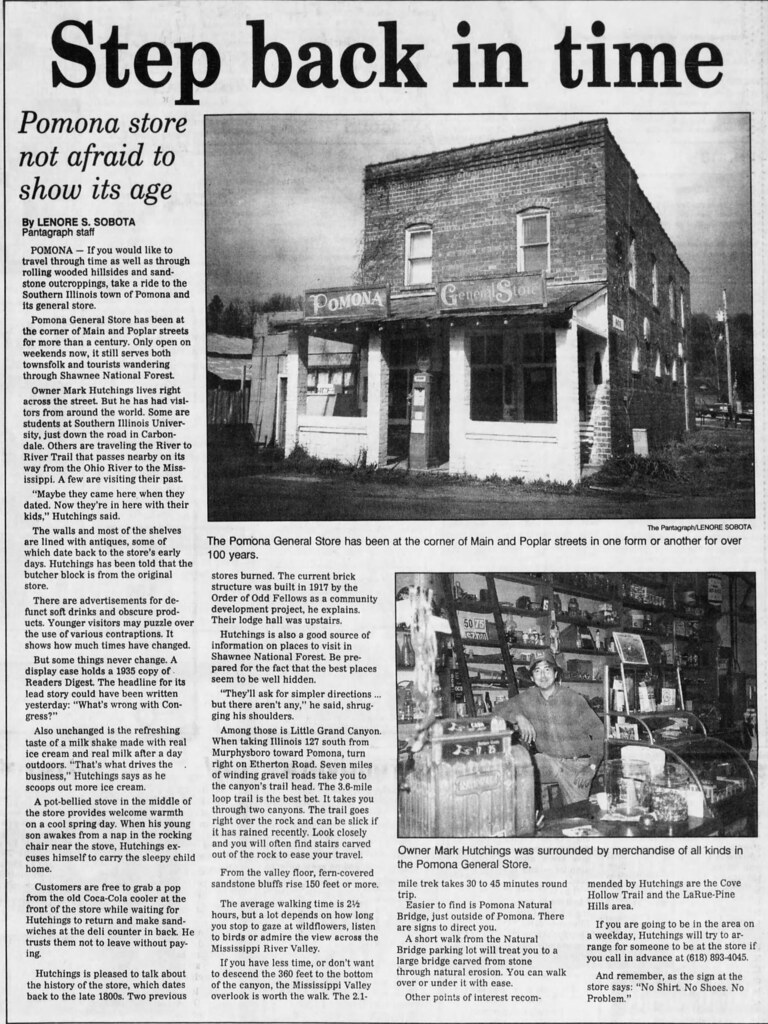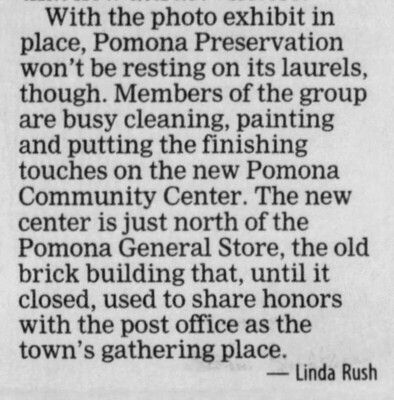Some photography over the years, as well as vintage photos.
Some rocks, Ann Arbor, Michigan
June 23, 2024
I thought to check Atlas Obscura to see if there were any oddities of interest nearby. I found out there is a colorful banded rock down the street that’s across from the bed and breakfast. Since every University of Michigan building along the way seems to have benches in front, I was able to get there without difficulty (with several breathers).
Before I did, however, I found a sculpture of interest, also listed in Atlas Obscura — Arriving Home (2007) by Dennis Oppenheim. When I saw it, my first thought was: If I step through it, what will happen to Edith Keeler? (Yes, I know the Guardian of Forever is an irregular shape, but in the moment I wasn’t that literal.)



When I arrived at the rock’s location, I found other rocks. All glacial erratics? They were of different shapes, sizes, and compositions. Unfortunately, I thought, a class that had added to the collection had had the rock’s surface carved with their year. A sign or plaque would have been better. Alas.
I found the banded rock I was seeking. It wasn’t called out as special or unusual — it was one rock among some rocks.1 I wouldn’t have minded taking it and some others home with me, if it were possible to lug boulders onto an Amtrak train.
This Ann Arbor District Library page has a bit more about the collection at 1100 North University, known as “Rock Specimens on the Lawn.” It makes me regret I didn’t become a geologist (or don’t have the mental makeup to have become one).
1 Apologies to Michael L. I know “some rocks” are always in groups of three, but I beg indulgence.
Twilight in the Rookery
May 9, 2024
This winter the Illinois Audubon Society held a Zoom series on the black-crowned night heron (BCNH), a species with worldwide distribution that is endangered in Illinois. At one time they nested in the Calumet area, but for the past few years they’ve moved their rookery to the red wolf exhibit at Lincoln Park Zoo.
This isn’t as odd as it may seem. The wolves aren’t a threat to the adults or to chicks/fledglings who stay out of reach. They are a deterrent tot raccoons, skunks, snakes, etc., who otherwise could reach eggs or chicks. It’s the same reason I believe people sometimes find fawns in the grass, shrubs, or flowers by their door. People’s presence and activity keep hungry predator mouths away. The BCNHs also like the mix of deciduous trees.
The zoo closes the red wolf exhibit while the BCNHs are nesting — something to keep in mind if you’re planning a spring/early summer visit to the zoo (maybe call ahead).
When as a participant in several Zoom calls about the BCNHs I received an invitation to “Twilight in the Rookery,” I went for it. I haven’t been to an evening event in years, and now usually by late afternoon I’m in agonizing pain. Admission was expensive, but I’m working and how else would I get to see the rookery? If I were in such bad shape I couldn’t make it, it would just be a donation. And now I can take a cab vs. two buses. Done.
The evening began near the Japanese macaque exhibit. I’m embarrassed to say how long it took me to find the partially hidden building. After introductory speeches, we were divided into groups to spread out over the area.
It was hard for me to stand for 30 to 40 minutes before we moved on (thankfully to an area with a bench — I didn’t care that it was wet).
At first I saw only a few BCNHs. Counts from previous years have been as high as 600. I started to see some flying around — incoming and outgoing. After we had moved to the second area, I saw more and more BCNHs peering at us from the foliage. It was evening and overcast, so a bit dark, but their shapes were clear. The biologists must have a methodology for finding and noting nest locations and counting. I couldn’t do it. I’d lose track.
Toward the end we saw the heron trap they’d mentioned. Should a BCNH be tempted to enter, a human observer brings the door down. The BCNH undergoes measurements, examinations, etc. It may even be fitted with a wee backpack — more on that in a bit.
At this point, I should mention someone had told me earlier about a friend who rescued great blue herons. They’re big and not always cooperative, and one had used its stabby bill to put its rescuer’s eye out. When you see videos on social media with gushing comments about how wild animals appear to be grateful to their rescuers, remember the rescuer with one eye.
On the way back, we stopped to watch two BCNHs fly and vocalize at each other. Our leader recognized them and said they do that often. We also saw a group of up to a dozen headed north.
Back at the half-hidden building, we passed around one of the wee backpacks a few lucky BCNHs are fitted with. They’re lightweight enough not to bother the bird. Somehow, a few have managed to lose theirs, although in some cases not before recording trips north to Wisconsin before their migration south. It’s like driving to Florida by way of Milwaukee or Green Bay. Why?
Heading out, I noticed people had stopped by the lions and thought, “Why not?” His Majesty was snoozing. One of the others rested unperturbed in a position reminiscent of a domestic cat. Another seemed to be resting, but keep a wary eye on me.
There was an extra bonus waiting for me outside the west gate — a huge amount of lilacs in full bloom. That heavenly scent. It was the last of the lilacs for me for 2024, and a happy way to end an informative, enjoyable Twilight in the Rookery.
Brood XIII Magicicada
If you had come to North America from Europe, especially Great Britain, in the 1500 to 1700s, you had to have been overwhelmed by some of the differences between home and here, especially in landscape and species. The British coped by giving some American animals the same or similar names as more familiar ones, even when the animal was clearly different. The European robin lent its name to the American robin. The European hedgehog was transformed into the groundhog (aka woodchuck).
The.2024 emergence of Brood XIII and Brood XIX in Illinois makes me wonder about those who moved here from Europe or even the eastern cities. With only the annual dog day cicada for reference, what would you think when one May day you found numerous holes in the ground, insect-shaped husks clinging to branches everywhere, and red bug eyes staring at you by the thousands, millions, maybe billions? And then you are deafened by their calls until they die off en masse several weeks later? They don’t appear again the next year, or the next, or the year after that — not for another 13 or 17 years. Nothing would have prepared you for them.
I recall the last emergence only vaguely, although I don’t think I saw any cicadas. I may have heard them a couple times, mostly while dining outside. I assumed they occur in western New York, but a U.S. Forest Service map shows they occur in a small area east of my hometown,
This time, however, I was able to see them in a few places — first at Black Partridge Woods, finally at Bremen Grove, with Riverside, Morton Arboretum, and Chicago Botanic Garden in between.
I love them and am going to miss them. If I live that long, I’ll be just shy of 79 when Brood XIII next appears.
When you think about a frail nymph burrowing underground, eating for 17 years, emerging, shedding its exoskeleton, drying out its wings (sometimes imperfectly), finding mates, laying eggs that hatch into nymphs that burrow underground to emerge and repeat the cycle in 17 years — it’s nature at its weirdest. Only through sheer numbers do they survive. As the Field Museum said, “Here for a good time, not for a long time.”
I hope the numbers are on their side in 17 years, with not too many paved over. Broods can go extinct, and I’d hate to see (or not see) that happen in 17 years.
Long live Brood XIII and Brood XIX.
Brood XIII cicadas — they’re here
Rare visible winter sunrise over Lake Michigan
During most of the winter in Chicago, the sky is a uniform leaden gray. Today, however, there was a moment of sunrise with some defined clouds. Right under the sunrise are the steel mills of Indiana with their plumes. During summer, the sun will rise over the Chicago Park District field house to your left.

David Wallach Fountain at Promontory Point
I spotted a photo in the “Snapshots” section under “Fawned Memories” with this caption and thought I should take my own photos (July 8, 2023).
Children drink from the David Wallach Memorial Fountain in 1955. When Wallach died in 1894, he left $5,000 for a fountain near the lake to supply water for “man and beast.” Sculptors Elisabeth Haseltine Hibbard and Frederick Cleveland Hibbard collaborated on the fountain, installed at the 55th Street entrance to Promontory Point in 1939. Elisabeth modeled the bronze fawn after a doe at the Lincoln Park Zoo. Her husband created the marble fountain, which includes a well in its base with water for pets and wildlife. Both had been students of Lorado Taft, who created the Fountain of Time sculpture on the Midway and taught at UChicago. Elisabeth also taught at the University from 1943 to 1950.
University of Chicago Magazine, Summer 2022




Summer’s rainy day rainbow
Drought, downpours, tornadoes, and rainbows
After months of abnormally dry to severe drought conditions, Chicago had a near record “rainfall event” the weekend of July 1–2, especially on Sunday.
To me, it seemed like a normal rain, but I don’t have a personal basement to worry about. I gave up any thought of outdoor activities and stuck to reading, TV, etc. I figured I’d be grateful if this rain, plus a few others that preceded it, would put a dent in the severe drought conditions.
As of July 11, Chicago was still abnormally dry, but look at the difference.
June 10, 2023:

Same area, July 9, 2023, a little less than a month later:

When I noticed the orange light on my weather radio flashing the evening of July 12, I was hoping for beach hazards or at worst a flash flood watch, but, no, it was a tornado watch. As the sky got darker, it flipped to the red light — tornado warning. Not long after that, the sirens started — an eerie sound in the eerie premature twilight.
Over the next hour or so I saw several reports of tornadoes, starting with Summit in the southwest suburbs. Then it seemed like they were everywhere — southwest, west, north.
The sky brightened for a moment, then darkened, then brightened again just as another brief deluge descended. I looked — yes, there was a rainbow (and a very faint second mirror image rainbow). It faded, then reappeared, or maybe it was a second one in a similar spot. The second, with a faint mirror image like the first, was the full arch, which I couldn’t capture from my window.
It faded as blue sky appeared to the east, then pink from the setting sun tinged the clouds that had piled up.

Rainbow at Promontory Point

Second rainbow at Promontory Point

Clouds over Lake Michigan to the east after the storms

Pink-tinged clouds to the east over Lake Michigan reflecting sunset
Pomona General Store
On a 2013 visit to Shawnee National Forest in southern Illinois, I came across this gem at a crossroads near the Pomona Natural Bridge. Finding the photos again, I was curious about what this building had been and when it closed for good.

May 25, 2013

May 25, 2013

May 25, 2013
It’s the Pomona General Store, and even the New York Times published an article about it.
At an Illinois Country Store, Nostalgia Sells Best
July 15, 1987
The store was built in 1876 when Pomona, about 15 miles southwest of Carbondale near the southern tip of Illinois, was a railroad town with more than 500 residents and a shipping point for produce.The original wooden store burned down in 1915. A rebuilt store burned in 1917, and a brick store was built the same year to replace it.
I dug around newspapers.com and found a little of the store’s most recent history starting with the 1970s, when media mentions picked up. Over the next couple of decades, the store changed hands a few times. It also attracted attention as a relic — an old-school general store in an era of big box stores. For years it seemed to be a center of Pomona community. Even after it closed, its location was used for community events like bake sales.










A few people have mentioned surprise the gas pump was in place (as of 2013) as they are “very collectible.” I found a photo from 2022 that shows the pump still there. Perhaps the Pomona community keeps a watchful eye on it.
The store must have closed between 2000 and 2002. Over the next decade or so, it deteriorated more than I would have expected. I’m reminded of what I saw of the TV series “Life After People,” which speculated how plants, wildlife, and other forces would eat away at the infrastructure and buildings humans have wrought after they were no longer maintained.

I imagine someday in Pomona the ivy will finally take over the store, and time will erase the memories.
Dan Ryan Woods aqueducts, this time with water
May 8, 2022
When I first visited the Dan Ryan Woods aqueducts in autumn, they were dry, so I wanted to go back in spring when there was more likely to be water. According to the Forest Preserves of Cook County, “The limestone aqueducts at Dan Ryan Woods were constructed by the CCC to prevent water from washing away soil on the steep ridges. Visitors can still walk alongside the aqueducts as they wind their way through the woods south of 87th St.” The aqueducts are one of my favorite things in Chicago.






























































































